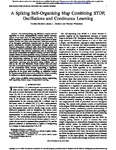A Spiking Self-Organising Map Combining STDP, Oscillations and Continuous Learning

Date
2014-05-01Author
Subject
Metadata
Show full item recordAbstract
The self-organizing map (SOM) is a neural network algorithm to create topographically ordered spatial representations of an input data set using unsupervised learning. The SOM algorithm is inspired by the feature maps found in mammalian cortices but lacks some important functional properties of its biological equivalents. Neurons have no direct access to global information, transmit information through spikes and may be using phasic coding of spike times within synchronized oscillations, receive continuous input from the environment, do not necessarily alter network properties such as learning rate and lateral connectivity throughout training, and learn through relative timing of action potentials across a synaptic connection. In this paper, a network of integrate-and-fire neurons is presented that incorporates solutions to each of these issues through the neuron model and network structure. Results of the simulated experiments assessing map formation using artificial data as well as the Iris and Wisconsin Breast Cancer datasets show that this novel implementation maintains fundamental properties of the conventional SOM, thereby representing a significant step toward further understanding of the self-organizational properties of the brain while providing an additional method for implementing SOMs that can be utilized for future modeling in software or special purpose spiking neuron hardware.
Description
Collections
Publisher
Place of Publication
Journal
Volume
Issue
Pagination
Recommended, similar items
The following license files are associated with this item:

